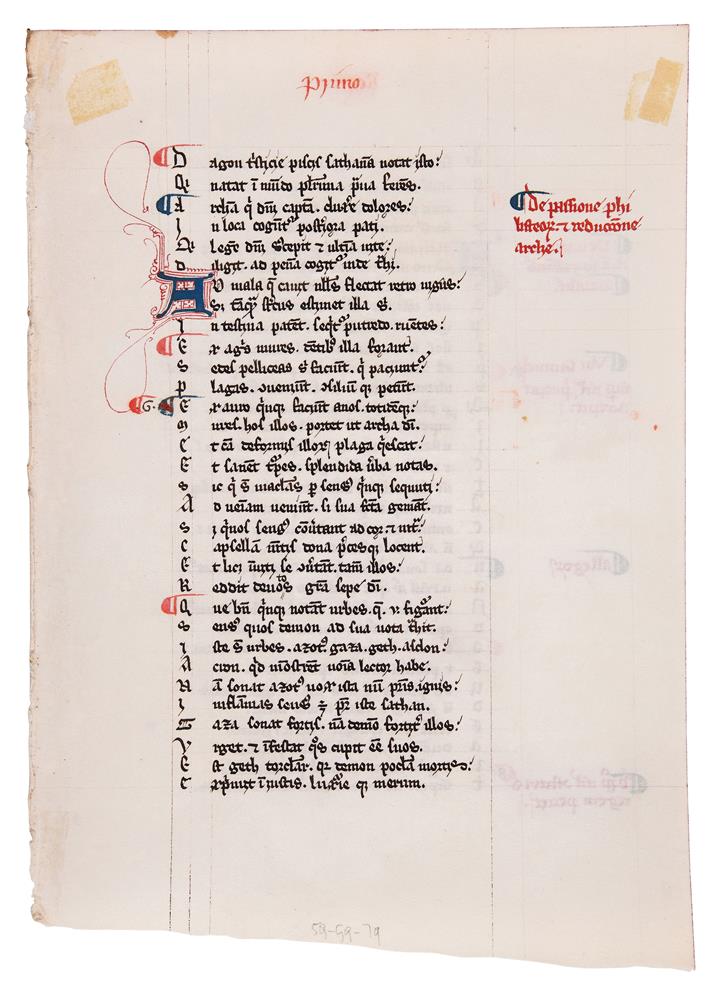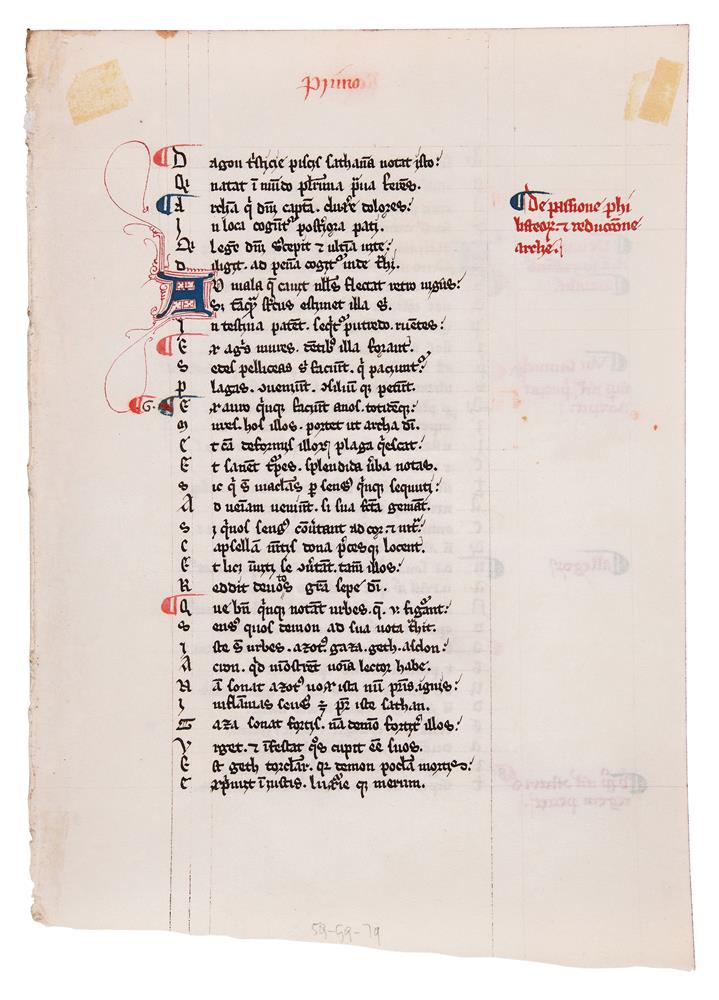Exodus, in Latin, large cutting from a monolithic Carolingian Bible manuscript on parchment [north or central Italy (perhaps Bobbio), first few decades of ninth century] Large cutting reused as a limp vellum binding on a copy of ‘Legge Dello Illustrissimo et Eccellentiss. S. il S. Duca di Firenze’ (Florence, 1517) still in situ, with top half of leaf and outer upright margins trimmed away, remains of two large columns, 21 lines ruled in drypoint, in a compressed early Carolingian minuscule with numerous earlier features (such as insular style ‘F’, a tall two-compartmented ‘e’ and a ‘t’ whose top-bar curls back and down on the left suggesting the shape of the pre-Carolingian letter) as well as a few features which point towards Insular influence (such as dotted ‘y’), occasional later interlinear additions (perhaps eleventh century), darkened in places and discoloured on outside, and scuffed on inside, some later retouching of a few letters inside covers, else in good and legible condition, cutting overall: 200 by 290 mm. While the basic outlines of the evolution of the Carolingian Bible have been sketched out (see Bischoff in his Mittelalterliche Studien II, pp. 12-19, Ganz and McKitterick in The Early Medieval Bible, 1994, and the Schøyen sale at Sotheby’s, 10 July 2012, lots 28-9), much still remains to be done, and each new early Carolingian fragment to emerge adds considerably to our knowledge. It is clear that while the standardised Carolingian Bible text produced by the abbeys of Tours came to dominate the Carolingian renaissance, they were not the only centre to respond to Charlemagne’s call for a corrected Bible text. Others are witnessed in the Theodulf Bible and the single leaf from another produced at Lorsch c. 800 which was identified by McKitterick (The Library, 6th series, 12, 1990, p. 31; sold in Sotheby’s, 10 July 2012, lot 29, for £93,650). Another fragmentary witness to a copy of Isaiah of the same date, but from an unidentified centre, was sold in our rooms, 8 July 2015, lot 10, for £18,600. This fragment may be the sole surviving witness to an Italian Carolingian Biblical text. The script of this cutting appears Italian, but with strong Insular influence. Such features point towards the cultural hub of Bobbio (founded by St. Columbanus in 612, with one of the finest medieval libraries in Europe, and finally suppressed in 1789), but do not exclude a number of other houses throughout northern and central Italy. In addition, its readings are not those of traditional Italian codices which commonly include Vetus Latina readings, and instead they adhere to the Vulgate, with only minor transcription errors. However, one physical fact suggests direct influence from the Carolingian heartlands of northern Europe, and opens the possibility that the parent codex may have been a very early attempt to adapt and domesticate the new Tours Bible. Strangely, the cutting here is from a leaf of near-identical proportions to that of the Tours Bibles, and yet is not in the rolling and rotund Tours script. The second leaf here wants only two characters or so from its upright margin, as well as some 29 or 30 lines from the top of the leaf. Thus its written space alone had original measurements of approximately 434 by 293 mm., with 50 or 51 lines in each column. Ganz records that Tours Bibles have a consistent size of 480 by 375mm (including margins as well as text) and text set in columns of 50-52 lines. As the production of our codex must have been within decades, if not years, of the initial arrival of the first Tours Bibles in Italy, it cannot have been made to replace a worn out copy, and we are left to suppose that an Italian centre recopied some Biblical books from a Tours exemplar on the same vast scale.
Exodus, in Latin, large cutting from a monolithic Carolingian Bible manuscript on parchment [north or central Italy (perhaps Bobbio), first few decades of ninth century] Large cutting reused as a limp vellum binding on a copy of ‘Legge Dello Illustrissimo et Eccellentiss. S. il S. Duca di Firenze’ (Florence, 1517) still in situ, with top half of leaf and outer upright margins trimmed away, remains of two large columns, 21 lines ruled in drypoint, in a compressed early Carolingian minuscule with numerous earlier features (such as insular style ‘F’, a tall two-compartmented ‘e’ and a ‘t’ whose top-bar curls back and down on the left suggesting the shape of the pre-Carolingian letter) as well as a few features which point towards Insular influence (such as dotted ‘y’), occasional later interlinear additions (perhaps eleventh century), darkened in places and discoloured on outside, and scuffed on inside, some later retouching of a few letters inside covers, else in good and legible condition, cutting overall: 200 by 290 mm. While the basic outlines of the evolution of the Carolingian Bible have been sketched out (see Bischoff in his Mittelalterliche Studien II, pp. 12-19, Ganz and McKitterick in The Early Medieval Bible, 1994, and the Schøyen sale at Sotheby’s, 10 July 2012, lots 28-9), much still remains to be done, and each new early Carolingian fragment to emerge adds considerably to our knowledge. It is clear that while the standardised Carolingian Bible text produced by the abbeys of Tours came to dominate the Carolingian renaissance, they were not the only centre to respond to Charlemagne’s call for a corrected Bible text. Others are witnessed in the Theodulf Bible and the single leaf from another produced at Lorsch c. 800 which was identified by McKitterick (The Library, 6th series, 12, 1990, p. 31; sold in Sotheby’s, 10 July 2012, lot 29, for £93,650). Another fragmentary witness to a copy of Isaiah of the same date, but from an unidentified centre, was sold in our rooms, 8 July 2015, lot 10, for £18,600. This fragment may be the sole surviving witness to an Italian Carolingian Biblical text. The script of this cutting appears Italian, but with strong Insular influence. Such features point towards the cultural hub of Bobbio (founded by St. Columbanus in 612, with one of the finest medieval libraries in Europe, and finally suppressed in 1789), but do not exclude a number of other houses throughout northern and central Italy. In addition, its readings are not those of traditional Italian codices which commonly include Vetus Latina readings, and instead they adhere to the Vulgate, with only minor transcription errors. However, one physical fact suggests direct influence from the Carolingian heartlands of northern Europe, and opens the possibility that the parent codex may have been a very early attempt to adapt and domesticate the new Tours Bible. Strangely, the cutting here is from a leaf of near-identical proportions to that of the Tours Bibles, and yet is not in the rolling and rotund Tours script. The second leaf here wants only two characters or so from its upright margin, as well as some 29 or 30 lines from the top of the leaf. Thus its written space alone had original measurements of approximately 434 by 293 mm., with 50 or 51 lines in each column. Ganz records that Tours Bibles have a consistent size of 480 by 375mm (including margins as well as text) and text set in columns of 50-52 lines. As the production of our codex must have been within decades, if not years, of the initial arrival of the first Tours Bibles in Italy, it cannot have been made to replace a worn out copy, and we are left to suppose that an Italian centre recopied some Biblical books from a Tours exemplar on the same vast scale.

.jpg?w=400)
.jpg?w=400)








Try LotSearch and its premium features for 7 days - without any costs!
Be notified automatically about new items in upcoming auctions.
Create an alert